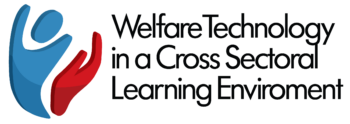Survey
SEIL -Smart, Easy and independent Living- project report
Background
This report is a part of Welfare Technology in a Cross Sectoral Learning Environment -Smart, Easy and independent Living (SEIL) –project. The project partners are Mosjøen videregående skole, Norway, Roc Friese Poort, The Netherlands, Fundação de Ensino Profissional da Praia da Vitória, Portugal, Seinäjoki vocational school (Sedu), Kouvola region vocational college (KSAO) and Seinäjoki University of Applied Sciences (SeAMK), Finland.
The objectives of this project are to combine the competences of technical, safety and health care education in order to boost the technological focus in health care education by applying a cross sectoral teaching and learning approach. At the beginning of the project, a study was performed to clarify the current knowledge and experience when using welfare technology among the students and teachers in health care, engineering and safety and security. This report presents the results of this study.
Aims
The aims of the study were to:
– analyze the current knowledge and experience in using welfare technology among the students and teachers in health care, engineering and safety and security
– analyze the needs of the employees (public and private sector)
– Identify the gap between the current knowledge and experience and the needs.
Method
Sedu led the development of the survey in close collaboration with SeAMK. All the partners gave their feedback on draft of the questionnaires and had a chance to translate the questionnaires to their national languages. Final versions of the questionnaires were translated into English, Portuguese and Finnish. SeAMK created the survey to the Webropol-platform.
There were three questionnaires, one for each group: students, teachers and employees. The questionnaire consisted of structured questions and open-ended questions. There were five or six background questions depending on respondent group: gender, country of residence, age, study/working field, work/teaching experience (employees and teachers) and school (students and teachers). In the questionnaire, there were totally 23 statements, where the options of responses were given as Likert´s scale. Statements’ subjects were Welfare technology and planning the use of welfare technology (7 statements), the working methods, tools and materials (8 statements) and general statements about welfare technology (8 statements). In the end, there were one open question for each group concerning about needs of training related to welfare technology and another question for employees about welfare technology devices they use at work.
Separate surveys were sent for selected external partner organizations, teachers and students in the field of social and health care and to students of technology and security fields. The target was to get at minimum 200 answers: 40 in each geographical location. The survey was open 5.12.2019-6.1.2020. The structured questions were analyzed by using the Webropol survey analysis and the couple of open-ended questions were analyzed by using the content analysis method. SeAMK led the analysis of the survey, shared results for the partners and prepared the report.
Results
There were totally 404 respondents to the questionnaires: 272 students, 74 teachers and 58 employees. In students, there were 115 respondents from Finland, 73 from Portugal, 50 from the Netherlands and 34 from Norway. In students, the respondents were 127 females, 142 males and 3, who described their gender as other. The most of the students (77,9 %) were at age 16-19 years. 52,6 % of the students named their filed of education as technology, 37,9 % as social and health care and 9,6 % as safety and security.
In teachers, there were 43 (58,1 %) respondents from Finland, 16 from the Netherlands, 12 from Portugal and 3 from Norway. 73,0 % of the teachers were females. 40,5 % of the teachers were at age 41-50 years and 29,7 % at age 51-60 years. Most (64, 9 %) of the teachers had teaching experience more than 10 years and most (68, 9 %) of them worked at social and health care field of education.
In employees, there were 21 respondents from Portugal, 18 from Norway, 17 from Finland and only two from the Netherlands. The most (86, 2 %) of the respondents were females and worked at the social and health care (69, 0 %). Age distribution was following: 25,9 % of the respondents were at the age under 30 years, 32,8 % at the age of 31-40 years, 22,4 % at the age of 41-50 years, 17,2 % at the age of 51-60 years and 1,7 % over 60 years old. Most of the employees (58, 6 %) had work experience more than 10 years.
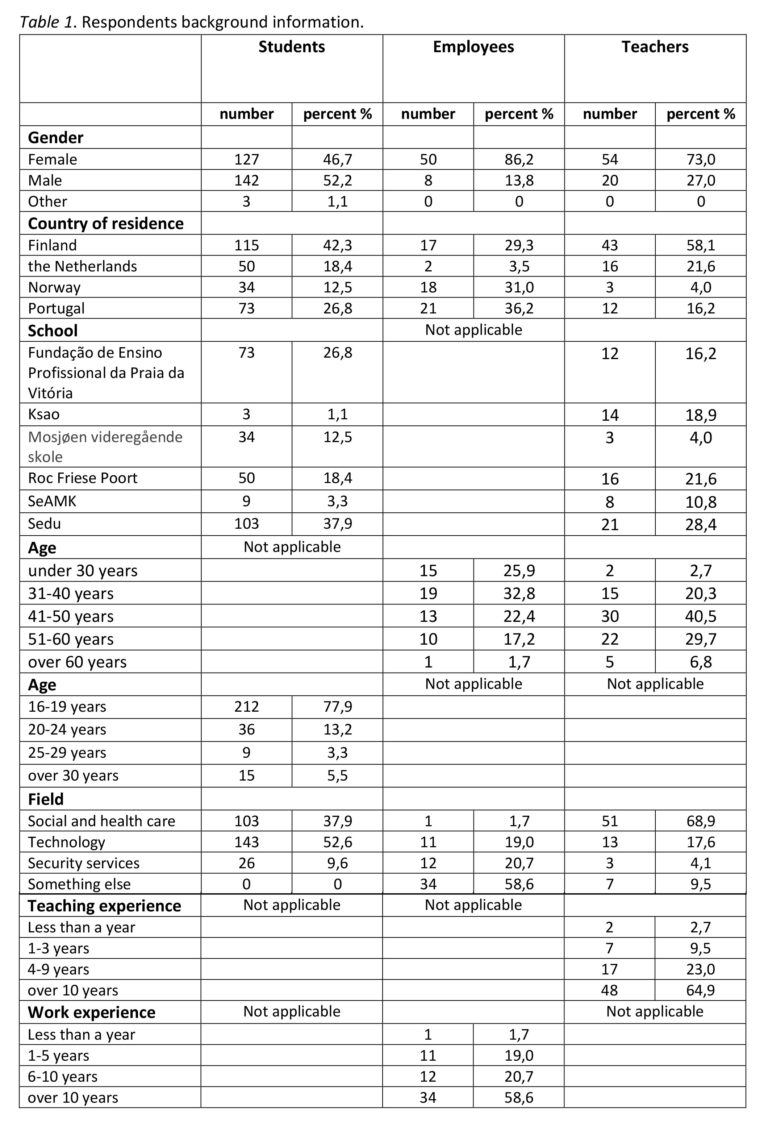
When combining the results of each group (students, teachers and employees), there are some topics that were known well and other that were known poorly. The weakest topic of the part “Welfare technology and planning the use of welfare technology” were: assessing the benefits of welfare technology in relation to its purchasing and maintenance costs, compiling a welfare technology plan that gives a client support to live at home, planning the use of welfare technology in work with clients and being aware where to purchase different welfare technology devices and equipment. As contrast to those topics that need more expertise, the best-known topic at area “Welfare technology and planning the use of welfare technology” was that, the respondents knew quite well, what is meant with the term welfare technology.
Figure 1. Welfare technology and planning the use of welfare technology. Answers in different groups: students, teachers and employees. The weakest parts marked as red and best known as green. (1= strongly disagree, 2= disagree, 3= neither agree or disagree, 4= agree, 5= strongly agree)
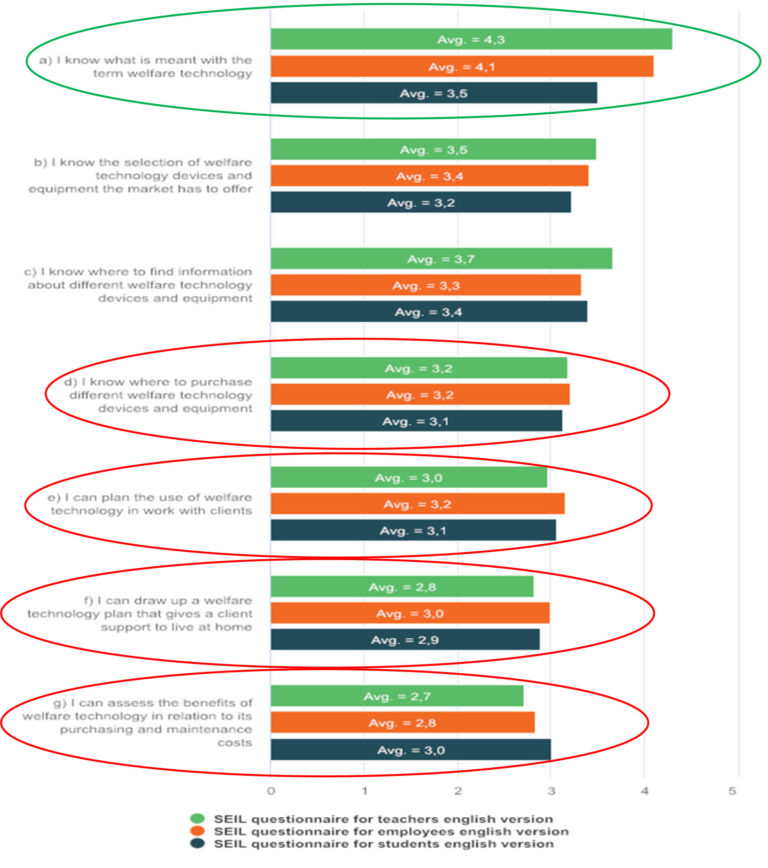
At the part “The working methods, tools and materials” more knowledge is needed especially in guiding clients in using different welfare technology devices, making sure that welfare technology devices will work and carrying out multi professional cooperation in initialization of welfare technology solutions. Instead, at this part the respondents thought they understand quite well the ethical principles that are based on the values of health and care sector when using welfare technology. The respondents also thought they understand quite well the aseptic practices related to use of welfare technology devices and equipment.
Figure 2. The working methods, tools and materials. Answers in different groups: students, teachers and employees. The weakest parts marked as red and best known as green. (1= strongly disagree, 2= disagree, 3= neither agree or disagree, 4= agree, 5= strongly agree)
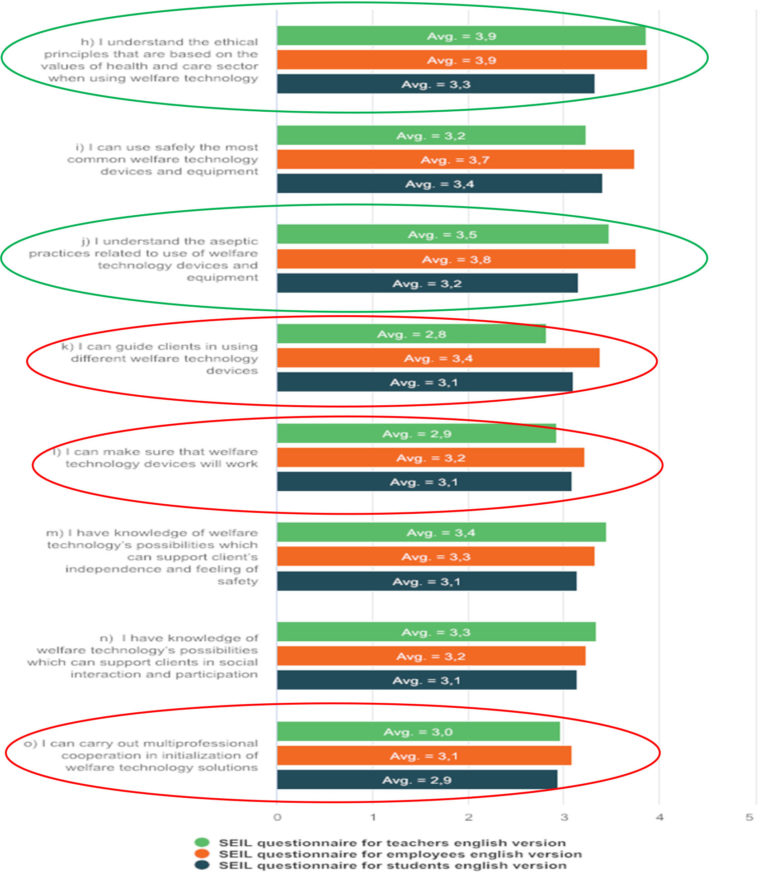
The third part in statements were general statements about welfare technology. At this part, the respondents thought that welfare technology has problems in functionality, it is difficult to motivate clients to use welfare technology and welfare technology has ethical challenges. However, the respondents thought that welfare technology makes working easier and elderly people can live longer at home with the support of welfare technology.
Figure 3. General statements about welfare technology. Answers in different groups: students, teachers and employees. The weakest parts marked as red and best known as green. Note that here bigger rate means that more improvement is needed (1= strongly disagree, 2= disagree, 3= neither agree or disagree, 4= agree, 5=strongly agree).
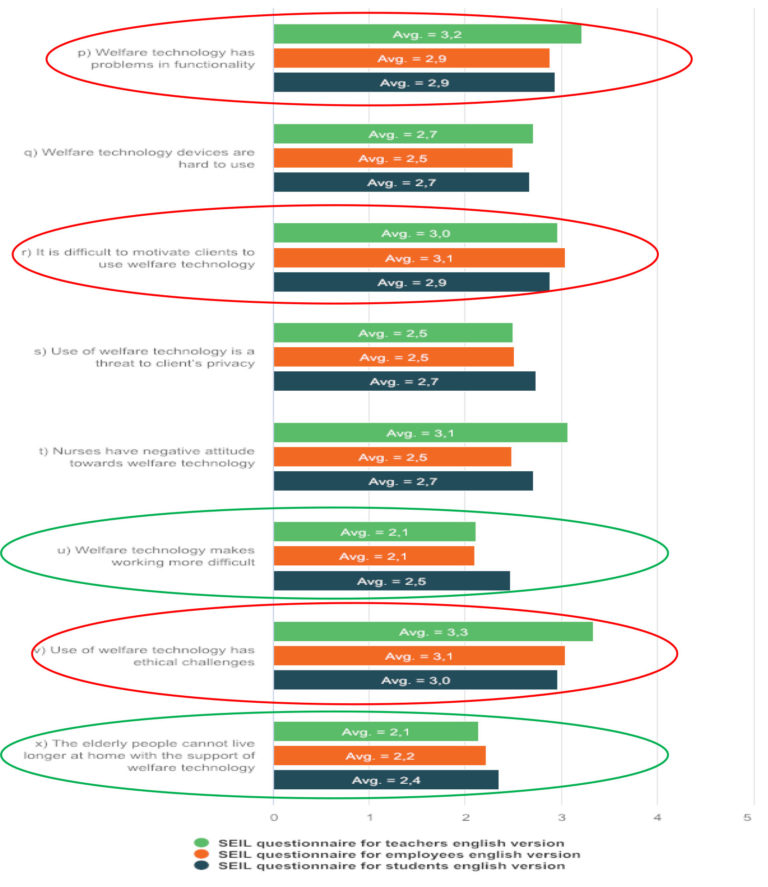
In the end of the questionnaire, there was an open question “what kind of training would you wish to have related to welfare technology?” There were totally 188 respondents (118 students, 44 teachers and 26 employees), who answered this question. In all group of respondents, three main categories can be seen in answers. Firstly, the respondents wished training about welfare technology in general. In addition, they needed training about welfare technology devices and their features. Finally, they wished concrete training for the use of welfare technology devices.
Table 2. Examples of answers given in open question “what kind of training would you wish to have related to welfare technology?” Three main categories.
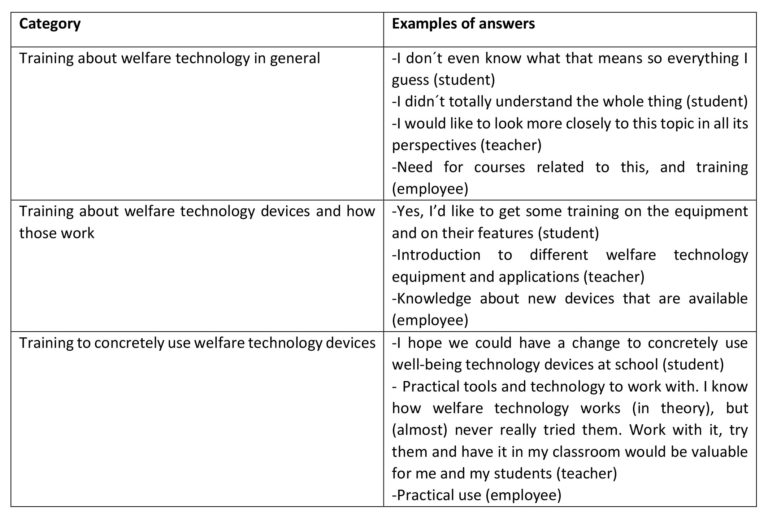
Added to those, some groups wished more training in few topics. The students wanted training about welfare technology advantages and disadvantages and information about where to purchase welfare technology devices. The teachers wished multi professional training among different professional fields. Teachers and employees wished additionally training about ethical challenges and how to brief clients on using welfare technology. Employees wished also computer training.
For employees, there was also another open question in questionnaire: “what kind of welfare technology devices and equipment do you use at work?” There were 25 responses for this question. The answers for this question were computers, smart phones, smart watches, GPS devices, video visitations, safety and door alarms, equipment to lift or move a patient, alternating pressure mattresses, blood sugar and blood pressure devices and oximeters and moving equipment.
Discussion
The aim of this study was to analyze the current knowledge and experience in using welfare technology among the students and teachers in health care, engineering and safety and security. The aim was also analyze the needs of the employees and identify the gap between the current knowledge and experience and the needs. The results shows, that more expertise is needed concerning the use of welfare technology in elderly care in health care, engineering and safety and security. The respondents have theoretical information about welfare technology, but they feel that they need knowledge that is more practical. The respondents have challenges with ethical principles in practice as well, even if they know these things in theory. Added to those, in results can be seen attitudes that influence the welfare technology. The teachers feel that nurses have negative attitudes towards welfare technology, but employees and students feel nurses’ attitudes are much better.
Conclusion
The results of the study were presented as Powerpoint-form and discussed in meeting in Portugal at 3.-7.2.2020. In the meeting, the learning outcomes of teaching of welfare technology were developed as teamwork based on study results.
Next learning outcomes were highlighted, when improving the welfare technology teaching:
-The students has knowledge of the possibilities and risks of welfare technology now and in the future.
-The student knows protocols and laws and regulations regarding welfare technology.
-The student has knowledge of ethical dilemmas in the use of welfare technology.
-The student can use welfare technology in the area of healthcare and can provide care at a distance.
-The student can advise, motivate and guide the client and staff in using services related to purchasing and using welfare technology.
-The student can make a welfare and technology plan for or with a client in a multi-professional team.
-The student can act in accordance with the vision and policy of the organization when using welfare technology.
-The student have the ability to critical thinking and reflection and be able to adapt to changes.
